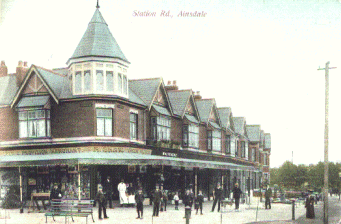

This site is very much under construction, and does not represent the 'finished product'. The following is just a sample of some of the text that may be included. For further information on Ainsdale, contact Ian Hampson at ian_h@globalnet.co.uk. Our sincere thanks go to Dr. Brian Garston for permission to use images from his extensive collection of photographs.
Ainsdale is situated about 3 miles south of the town of Southport on England's northwest coast. Nowadays, due to continued building, there is no actual separation of the town and village. They simply merge in to one large area, with a population totaling around 90,000.
However, it wasn't always like this, and it is our aim to present some of the history of the village within these pages, and combine this with life today.
Ainsdale predates Southport by many hundreds of years, being listed in the Domesday book as Einulvesdel. This apparently was the valley occupied by a Scandinavian by the name of Einulfr.
It is common belief that the first settlers to these windy and inhospitable shores were of Scandinavian origin, possibly driven out of Ireland over 1000 years ago. This area of the coast was very different to the present day. There were no large built up areas to ease the wind, howling off the Irish Sea, so consequently the area was quite isolated and travellers were rare.
Many of the old names in the area are adapted from old Norse. For example, to the north, the village of Birkdale probably takes it's name from a compound of two Old Norse words, birki meaning "birch-copse" and dalr meaning dale.
The early settlers in Ainsdale were mostly farmers or farm laborers, as there was little call for anything else until the beginning of the 1800's. As was normal for the day, few people could read or write, so documents from Ainsdale's early past are very rare. Those that could write, tended to spell words exactly as they pleased, as was common for the period, hence Ainsdale being spelt Aynaltesdale in a cattle grazing agreement dated 1377.
The railway came to the area in 1848, and with it, a new type of resident, the first commuters. They were mainly wealthy people who had made their money in the nearby port of Liverpool. It was through the influx of this type of person, that the village began to come to life. There was call for all the usual services of the day, such as blacksmiths, grocers and butchers, and the village began to take on its familiar shape, and expanded outwards.

The biggest growth in population occurred around the mid 1960's,
into the 1970's. Much of the old, rural aspect of the village
was swept away, and replaced by large housing estates, although
the original character of the shopping area has in general been
preserved to this day.
Even with all the changes that have occurred over the past 30
years, Ainsdale is still a pleasant place to make your home.
Further updates will take place to this site once we get the rest
of our photographs processed!